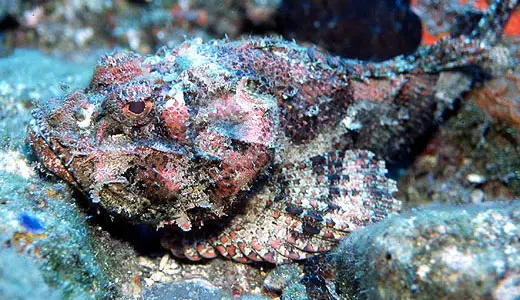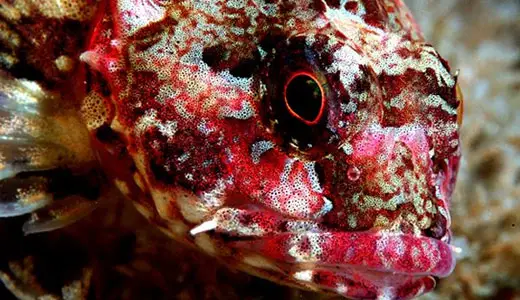Scorpionfish
The Scorpionfish are part of the Scorpaenidae family and and primarily found in the colder regions of the worlds oceans. Although Scorpaenids populate most of oceans only a handful of different Scorpaenids populate the worlds warmer oceans. The Scorpaenidae family is made up of around 400 known species which include lionfish, stonefish and devilfish. Scorpaenids are definitely not at the bottom of the food chain and most Scorpaenids, especially Scorpionsfish are masters of camouflage and bled into their environment with incredible ease and efficiency.

Showing off camouflage abilities
Scorpionfish will use their effective camouflage to to blend it while waiting for hapless prey to saunter on by catching them unawares. Its not only smaller prey that the Scorpionfish will go after, as the Scorpionfish have massive mouths they are able to swallow prey that are over half the size of the Scorpionfish itself. Any potential predator of the Scorpionfish needs to be incredibly careful when approaching a Scorpionfish as they will certainly make a very spiky and uncomfortable meal (if the predator can even spot one, considering its camouflage capabilities!). Comforts aside, the main danger is that some of the spines on the Scorpionfish are venomous and provide sting that is is advisable to avoid, most of the more dangerous (potentially lethal, even to a human) spines are usually found around the anal and dorsal areas of the Scorpionish.
As the Scorpionfish waits to ambush its prey the extent of its camouflage becomes more apparent as not only will the Scorpionfish blend in to nearby rocks and coral/reef but the ability to blend in works to lure unsuspecting to in thinking that the Scorpionsfish is a piece of reef which many of its prey would normally consider a safe haven from predators. If prey falls for this and is lured into a false sense of security then there is very small chance it will escape as the Scorpionfish uses a vacuum technique by opening its mouth – instantaneously sucking in the prey in a matter of mili-seconds.

Predators beware
This style of life does however have side effects as the Scorpionfish will often become riddles with parasites, algae and crustaceans due to the amount of time spent motionless waiting for prey. Fortunately for the Scorpionfish this isn’t much of a problem as the Scorpionfish has the ability to shed its outer layer, effectively getting rid of any stowaways.
Scorpionfish an for the most part solitary creatures, being found in pairs on in the mating season like the vast majority of Scorpaenids. As the Scorpionfish are masters of camouflage you will find that their habitat varies from fish to fish as no matter the habitat you can be sure Scorpionfish somewhere have adapted to it.
As you would expect from a venomous animal the Scorpionfish can give a fantastic display of colors to warn off predators however the Scorpionfish will not display these colors permanently like some animals as to do so would greatly hinder its camouflage abilities, instead the Scorpionfish uses a technique called ‘flashing’ where they can display their colors at will.



would you all send me some information of the scorpion fish to my e-mail
i like the camo fish boyeeeeeeeeeeeee